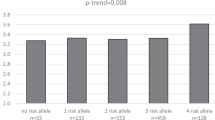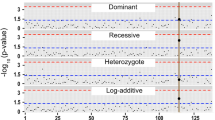Abstract
Background/Objectives:
Several studies reported associations of the lactase gene (LCT) polymorphism −13910C>T (rs4988235) with obesity-related variables and obesity in adults. This study aimed to replicate previously reported associations in a population sample of Portuguese young adults.
Subjects/Methods:
We genotyped 447 subjects from central and northern regions of Portugal (mean age 20.81±4.24 years) for the lactase variant −13910C>T (rs4988235), using TaqMan probes. Anthropometric variables (weight, height and body fat) were measured using standardized procedures and body mass index (BMI) (kg/m2) was calculated.
Results:
Frequency of genotypes was 35.8% CC (lactase nonpersistent, LNP), 48.1% CT and 16.1% TT, consistent with Hardy–Weinberg equilibrium (P=1). The frequency for the minor −13910 T allele was 0.402. Assuming a dominance model for the lactase persistence (LP) minor T-allele, linear regression models showed statistically significant associations between the LP genotype CT/TT and BMI, fat mass and weight (β=1.114, P=0.003; β=1.309, P=0.007 and β=2.67, P=0.021, respectively) after adjustment for age and sex. In concordance, logistic regression showed significant association between LP genotype CT/TT and overweight/obesity (OR=1.77; CI 1.08–2.92; P=0.023), as well as with high fat percentage ranges (OR=1.58; CI 1.01–2.46; P=0.041), when adjusting for age and sex. No significant interaction was obtained between the LCT polymorphism and physical activity for BMI (Pint=0.454) or FAT % (Pint=0.421).
Conclusions:
In the Portuguese sample of young adults, the lactase −13910C>T polymorphism revealed significant associations with the obesity-related anthropometric variables BMI, fat mass and weight, and previously observed associations with the obesity risk were also confirmed.
This is a preview of subscription content, access via your institution
Access options
Subscribe to this journal
Receive 12 print issues and online access
$259.00 per year
only $21.58 per issue
Buy this article
- Purchase on Springer Link
- Instant access to full article PDF
Prices may be subject to local taxes which are calculated during checkout
Similar content being viewed by others
References
Swallow DM . Genetics of lactase persistence and lactose intolerance. Annu Rev Genet 2003; 37: 197–219.
Haberkorn BC, Ermens AA, Koeken A, Cobbaert CM, van Guldener C . Improving diagnosis of adult-type hypolactasia in patients with abdominal complaints. Clin Chem Lab Med 2011; 50: 119–123.
Ingram CJ, Mulcare CA, Itan Y, Thomas MG, Swallow DM . Lactose digestion and the evolutionary genetics of lactase persistence. Hum Genet 2009; 124: 579–591.
Tishkoff SA, Reed FA, Ranciaro A, Voight BF, Babbitt CC, Silverman JS et al. Convergent adaptation of human lactase persistence in Africa and Europe. Nat Genet 2007; 39: 31–40.
Torniainen S, Parker MI, Holmberg V, Lahtela E, Dandara C, Jarvela I . Screening of variants for lactase persistence/non-persistence in populations from South Africa and Ghana. BMC Genet 2009; 10: e31.
Enattah NS, Sahi T, Savilahti E, Terwilliger JD, Peltonen L, Jarvela I . Identification of a variant associated with adult-type hypolactasia. Nat Genet 2002; 30: 233–237.
Lewinsky RH, Jensen TG, Moller J, Stensballe A, Olsen J, Troelsen JT . T-13910 DNA variant associated with lactase persistence interacts with Oct-1 and stimulates lactase promoter activity in vitro. Hum Mol Genet 2005; 14: 3945–3953.
Olds L, Sibley E . Lactase persistence DNA variant enhances lactase promoter activity in vitro: functional role as a cis regulatory element. Hum Mol Genet 2003; 12: 2333–2340.
Troelsen JT, Olsen J, Moller J, Sjostrom H . An upstream polymorphism associated with lactase persistence has increased enhancer activity. Gastroenterology 2003; 125: 1686–1694.
Kettunen J, Silander K, Saarela O, Amin N, Müller M, Timpson N et al. European lactase persistence genotype shows evidence of association with increase in body mass index. Hum Mol Genet 2010; 19: 1129–1136.
Corella D, Arregui M, Coltell O, Portolés O, Guillem-Sáiz P, Carrasco P et al. Association of the LCT −13910C>T polymorphism with obesity and its modulation by dairy products in a Mediterranean population. Obesity 2011; 19: 1707–1714.
Almon R, Álvarez-León EE, Serra-Majem L . Association of the European lactase persistence variant (LCT-13910C>T polymorphism) with obesity in the Canary Islands. PLoS One 2012; 7: e43978.
Lamri A, Poli A, Emery N, Bellili N, Velho G, Lantieri O et al. The lactase persistence genotype is associated with body mass index and dairy consumption in the D.E.S.I.R. study. Metabolism 2013; 62: 1323–1329.
Bergholdt HK, Nordestgaard BG, Ellervik C . Milk intake is not associated with low risk of diabetes or overweight-obesity: a Mendelian randomization study in 97,811 Danish individuals. Am J Clin Nutr 2015; 102: 487–496.
Malek AJ, Klimentidis YC, Kell KP, Fernández JR . Associations of the lactase persistence allele and lactose intake with body composition among multiethnic children. Genes Nutr 2013; 8: 487–494.
Albuquerque D, Nóbrega C, Manco L . The lactase persistence −13910C>T polymorphism shows indication of association with abdominal obesity among Portuguese children. Acta Paediatr 2013; 102: e153–e157.
Dias H, Muc M, Padez C, Manco L . Association of polymorphisms in 5-HTT (SLC6A4) and MAOA genes with measures of obesity in young adults of Portuguese origin. Arch Physiol Biochem 2016; 122: 8–13.
Muc M, Padez C, Manco L . Influence of physical activity on the association between the FTO variant rs9939609 and adiposity in young adults. Am J Hum Biol 2015; 27: 734–738.
Purcell S, Neale B, Todd-Brown K, Thomas L, Ferreira MRA, Bender D et al. PLINK: a tool set for whole-genome association and population-based linkage analyses. Am J Hum Genet 2007; 81: 559–575.
Manco L, Pires S, Lopes AI, Figueiredo I, Albuquerque D, Alvarez M et al. Distribution of the −13910C>T polymorphism in the general population of Portugal and in subjects with gastrointestinal complaints associated with milk consumption. Ann Hum Biol 2013; 40: 205–208.
Coelho M, Luiselli D, Bertorelle G, Lopes AI, Seixas S, Destro-Bisol G, Rocha J . Microsatellite variation and evolution of human lactase persistence. Hum Genet 2005; 117: 329–339.
Enattah NS, Kuokkanen M, Forsblom C, Natah S, Oksanen A, Jarvela I et al. Correlation of intestinal disaccharidase activities with the C/T-13910 variant and age. World J Gastroenterol 2007; 13: 3508–3512.
Berkey CS, Colditz GA, Rockett HR, Frazier AL, Willett WC . Dairy consumption and female height growth: prospective cohort study. Cancer Epidemiol Biomarkers Prev 2009; 18: 1881–1887.
Berkey CS, Rockett HR, Willett WC, Colditz GA . Milk, dairy fat, dietary calcium, and weight gain: a longitudinal study of adolescents. Arch Pediatr Adolesc Med 2005; 159: 543–550.
Kratz M, Baars T, Guyenet S . The relationship between high-fat dairy consumption and obesity, cardiovascular, and metabolic disease. Eur J Nutr 2013; 52: 1–24.
Lu L, Xun P, Wan Y, He K, Cai W . Long-term association between dairy consumption and risk of childhood obesity: a systematic review and meta-analysis of prospective cohort studies. Eur J Clin Nutr 2016; 70: 414–423.
Abreu S, Santos R, Moreira C, Santos PC, Vale S, Soares-Miranda L et al. Milk intake is inversely related to body mass index and body fat in girls. Eur J Pediatr 2012; 171: 1467–1474.
Marques-Vidal P, Gonçalves A, Dias CM . Milk intake is inversely related to obesity in men and in young women: data from the Portuguese Health Interview Survey 1998–1999. Int J Obes (Lond) 2006; 30: 88–93.
Acknowledgements
Contract grant sponsor: Portuguese Foundation for Science and Technology (FCT): UID/ANT/00283/2013.
Author information
Authors and Affiliations
Corresponding author
Ethics declarations
Competing interests
The authors declare no conflict of interest.
Rights and permissions
About this article
Cite this article
Manco, L., Dias, H., Muc, M. et al. The lactase −13910C>T polymorphism (rs4988235) is associated with overweight/obesity and obesity-related variables in a population sample of Portuguese young adults. Eur J Clin Nutr 71, 21–24 (2017). https://doi.org/10.1038/ejcn.2016.164
Received:
Revised:
Accepted:
Published:
Issue Date:
DOI: https://doi.org/10.1038/ejcn.2016.164
This article is cited by
-
Evidence for a causal association between milk intake and cardiometabolic disease outcomes using a two-sample Mendelian Randomization analysis in up to 1,904,220 individuals
International Journal of Obesity (2021)
-
Gut-microbiome-related LCT genotype and 2-year changes in body composition and fat distribution: the POUNDS Lost Trial
International Journal of Obesity (2018)



